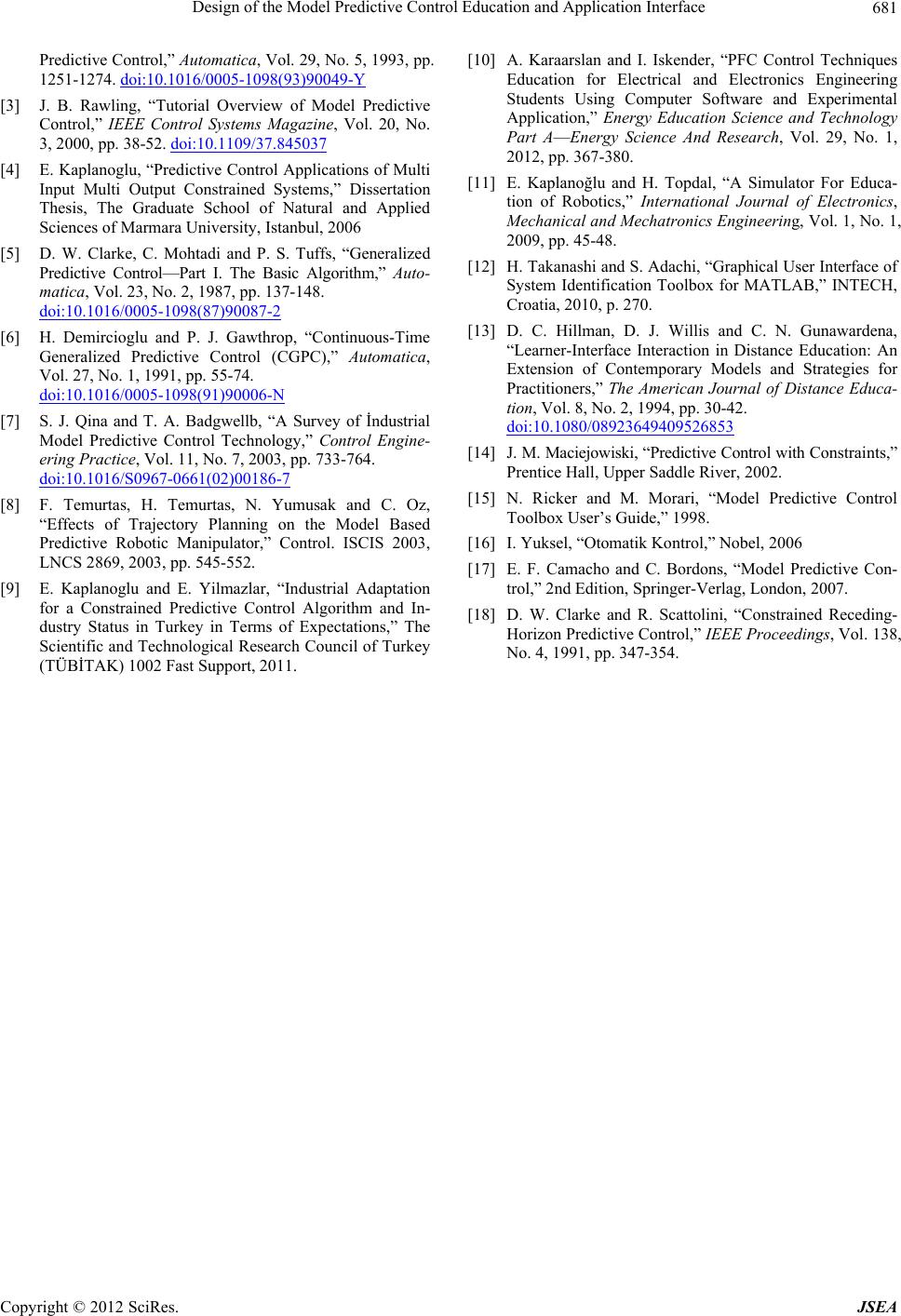
Design of the Model Predictive Control Education and Application Interface 681
Predictive Control,” Automatica, Vol. 29, No. 5, 1993, pp.
1251-1274. doi:10.1016/0005-1098(93)90049-Y
[3] J. B. Rawling, “Tutorial Overview of Model Predictive
Control,” IEEE Control Systems Magazine, Vol. 20, No.
3, 2000, pp. 38-52. doi:10.1109/37.845037
[4] E. Kaplanoglu, “Predictive Control Applications of Multi
Input Multi Output Constrained Systems,” Dissertation
Thesis, The Graduate School of Natural and Applied
Sciences of Marmara University, Istanbul, 2006
[5] D. W. Clarke, C. Mohtadi and P. S. Tuffs, “Generalized
Predictive Control—Part I. The Basic Algorithm,” Auto-
matica, Vol. 23, No. 2, 1987, pp. 137-148.
doi:10.1016/0005-1098(87)90087-2
[6] H. Demircioglu and P. J. Gawthrop, “Continuous-Time
Generalized Predictive Control (CGPC),” Automatica,
Vol. 27, No. 1, 1991, pp. 55-74.
doi:10.1016/0005-1098(91)90006-N
[7] S. J. Qina and T. A. Badgwellb, “A Survey of İndustrial
Model Predictive Control Technology,” Control Engine-
ering Practice, Vol. 11, No. 7, 2003, pp. 733-764.
doi:10.1016/S0967-0661(02)00186-7
[8] F. Temurtas, H. Temurtas, N. Yumusak and C. Oz,
“Effects of Trajectory Planning on the Model Based
Predictive Robotic Manipulator,” Control. ISCIS 2003,
LNCS 2869, 2003, pp. 545-552.
[9] E. Kaplanoglu and E. Yilmazlar, “Industrial Adaptation
for a Constrained Predictive Control Algorithm and In-
dustry Status in Turkey in Terms of Expectations,” The
Scientific and Technological Research Council of Turkey
(TÜBİTAK) 1002 Fast Support, 2011.
[10] A. Karaarslan and I. Iskender, “PFC Control Techniques
Education for Electrical and Electronics Engineering
Students Using Computer Software and Experimental
Application,” Energy Education Science and Technology
Part A—Energy Science And Research, Vol. 29, No. 1,
2012, pp. 367-380.
[11] E. Kaplanoğlu and H. Topdal, “A Simulator For Educa-
tion of Robotics,” International Journal of Electronics,
Mechanical and Mechatronics Engineering, Vol. 1, No. 1,
2009, pp. 45-48.
[12] H. Takanashi and S. Adachi, “Graphical User Interface of
System Identification Toolbox for MATLAB,” INTECH,
Croatia, 2010, p. 270.
[13] D. C. Hillman, D. J. Willis and C. N. Gunawardena,
“Learner-Interface Interaction in Distance Education: An
Extension of Contemporary Models and Strategies for
Practitioners,” The American Journal of Distance Educa-
tion, Vol. 8, No. 2, 1994, pp. 30-42.
doi:10.1080/08923649409526853
[14] J. M. Maciejowiski, “Predictive Control with Constraints,”
Prentice Hall, Upper Saddle River, 2002.
[15] N. Ricker and M. Morari, “Model Predictive Control
Toolbox User’s Guide,” 1998.
[16] I. Yuksel, “Otomatik Kontrol,” Nobel, 2006
[17] E. F. Camacho and C. Bordons, “Model Predictive Con-
trol,” 2nd Edition, Springer-Verlag, London, 2007.
[18] D. W. Clarke and R. Scattolini, “Constrained Receding-
Horizon Predictive Control,” IEEE Proceedings, Vol. 138,
No. 4, 1991, pp. 347-354.
Copyright © 2012 SciRes. JSEA